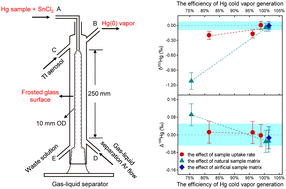The efficiency of Hg cold vapor generation and its influence on Hg isotope analysis by MC-ICP-MS†
Abstract
The application of mercury (Hg) stable isotopes as tracers of Hg biogeochemical cycling requires high accuracy and precision for Hg isotope analysis. A common method for sample introduction in Hg isotope analyses is cold vapor generation (CVG), which converts soluble Hg(II) in sample solutions into Hg(0) vapor that is then transported to the plasma. However, the efficiency of Hg CVG and its influence on Hg isotope analysis have not been fully quantified. In this study we systematically investigate the Hg CVG efficiency and the influence of non-quantitative CVG on Hg isotope analysis. Our results show that Hg CVG can be strongly affected by the sample uptake rate, sample matrix, and the design of the gas–liquid separator (GLS). Increases of the sample uptake rate shorten the reaction time of CVG, and thus can decrease the CVG efficiency and induce mass-dependent fractionation (MDF) due to incomplete volatilization of Hg(0). Different types and concentrations of sample matrices also result in different degrees of suppression on Hg CVG and Hg isotope fractionation via multiple mechanisms including partial volatilization of Hg(0), incomplete Hg(II) reduction and/or reoxidation of Hg(0), but matrix separation significantly alleviates or even eliminates the suppression on Hg CVG. The design of GLS has a particularly important impact on Hg CVG and thus the accuracy of Hg isotope analysis. Generally, GLSs that have larger reaction surfaces that promote more complete Hg(II) reduction and Hg(0) volatilization tend to show higher CVG efficiency. In addition, the degrees of suppression on Hg CVG can be variable even for samples with the same matrix. Thus, the Hg isotope fractionation caused by non-quantitative Hg CVG cannot always be fully corrected by matrix matching and standard-sample bracketing. We conclude that ensuring high, near 100% CVG efficiency by performing matrix separation, adopting an optimal design of GLS, and tuning the sample uptake rate is the key to obtaining the highest accuracy and precision in Hg isotope analysis.

- This article is part of the themed collection: JAAS HOT Articles 2023


 Please wait while we load your content...
Please wait while we load your content...